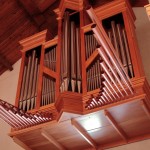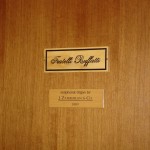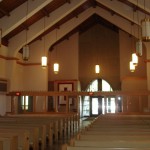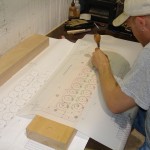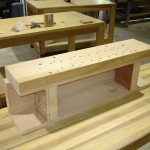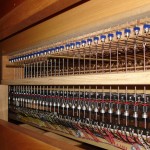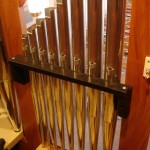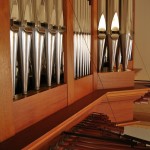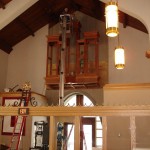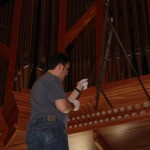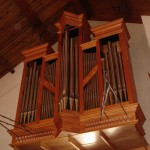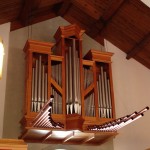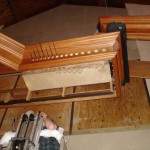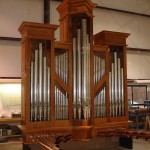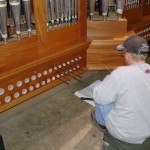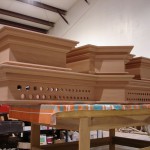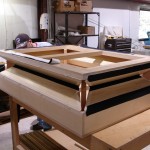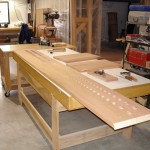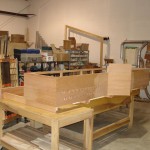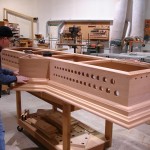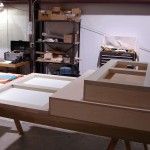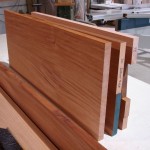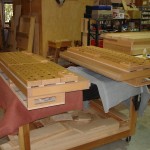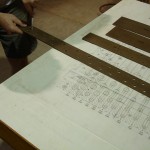Mt. Lebanon United Lutheran installed a Ruffatti organ in the front of their sanctuary in November 2002, and we took over the regular maintenance of the instrument in September 2004. The church’s Director of Music and Organist, Russell J. Weismann, expressed interest in having a proposal to add the three prepared-for stops in the Choir, as well as replacing the electronic voices in that division with real pipes. While nothing came of it immediately, we had begun a dialogue with the church; when Russ left to pursue a graduate degree at Yale, the discussions continued with his successor, Larry Allen, and Russ was retained by the church as their consultant. After several years of relative inactivity, the project began to gather momentum in 2007, and a contract was signed in February 2008.
Although there were numerous very good arguments as to why the Choir additions should have taken precedence, we were also faced with the fact that many people “hear with their eyes,” and they would have wondered, “What did we just spend all that money on?” had we only installed new stops inside that division, out of sight. The pastor was adamant that we could not erect an empty case in the back, so the idea of building the Antiphonal division without pipes never gained traction, and in the end all agreed that the best overall course of action — given the available funds — was to install the Antiphonal complete, and build and install the additional chest inside the Choir box without its pipes.
The Antiphonal case is of mahogany, like its big sister at the front of the church, and is simply shellacked and lacquered (we’ve actually always used a water-based topcoat, not lacquer, but shellac helps “pop” the grain, especially on figured woods). Our initial thinking had been that this division would sit atop some sort of support structure, anchored to the rooms on either side of the narthex. In my first meeting with the engineer, I jokingly suggested that maybe we could hang the Antiphonal from the ceiling — I had just received the book ein Hauch, ein Ton, about the Klais organ at Cologne Cathedral in Germany that hangs from the church’s ceiling on steel rods. He glanced up and remarked that the blueprints showed a massive beam in that area, to support the church’s large metal steeple, and hanging the organ might be the simplest solution. In the end, it was, and the entire Antiphonal is supported by four 3⁄8” steel cables, registering into a steel support structure at either end of the case impost. These steel supports are mortised into the impost and secured with bolts through the wood (the heads are hidden beneath the moldings), so the impost would literally have to tear itself apart in order for the organ to fall. The walkboard behind the case simply anchors the case so it doesn’t sway.
All three new chests — C and Cs of the Antiphonal and the one-piece Choir — are our standard design of slider chest, with the addition of electric pulldowns below the windbox. The Antiphonal was an interesting challenge in that it has two complete sets of channels in the space normally used for one set. The three flue stops sit above one set of channels, with a slider for each stop between the chest table and toeboard in the usual fashion. The Trompette en Chamade is winded from the other set of channels, but through the bottom board of the chest via conductors directly into the wooden reed boot blocks mounted to the inside face of the impost; since this stop has its own set of channels and no slider, it functions as a unit stop, and thus can be played from any division, or several, at will. Even with the relatively tight spacing that results, everything is still quite accessible, and the pulldown magnets even fit in a single row, which helped to keep the impost from becoming too tall and visually clumsy.
Ruffatti had planned that a chamade would be the only reed available on the Great. In the time leading up to the contract signing, Larry had suggested the possibility of extending the Pedal unit reed and duplexing it up to the Great. Coming from a tracker background, I wasn’t accustomed to thinking in these terms, but the idea made eminent sense: this would provide both a typical chorus reed, as well as a “party horn,” for the primary division of the organ, and the physical proximity of the Great chest and Bombarde pipes meant that tuning differences should be minor at worst. We provided 17 treble pipes on a small direct-valve-electric-action chest, located near the main Pedal chest that included the original trebles of the Bombarde.
The Diapason, Octave and Fifteenth were made of the normal tin/lead pipe alloys, while the Trompette en Chamade was built in satin copper. Fred Oyster, the pipemaker for the reeds, suggested a racking for the chamade of small square steel tubing, which were painted a medium brown color; the racks are anchored into the impost above the reed blocks, and are supported by 4 thin stainless-steel cables. The overall effect is that the racks almost disappear, and so don’t distract from the stunning effect of the resonators projecting out from the case. The chamade was conceived as a full-bodied chorus reed that just happens to lie sideways instead of standing vertically, and its tonal effect is exactly what was desired: neither too thin like a Spanish trumpet, nor too thick like a Tuba. We also resisted the temptation to make the stop too loud, in order to make it more useful for the organist — and more pleasurable for the parishioners.
Zamberlan & Co.’s additions are in bold
GREAT (Manual II, C1-c61)
Montre 8’
Flute Harmonique 8’ (elec.)
Bourdon 8’
Octave 4’
Flûte Ouverte 4’
Doublette 2’
Fourniture IV 11⁄3’
Trompette 8’ (PD + 17 new pipes)
Trompette en Chamade 8’ (AN)
Chimes (prep.)
Tremulant
Great 16’
Unison Off
Great 4’
MIDI A
SWELL (Manual III, C1-c61, enclosed)
Bourdon Doux 16’
Viola Pomposa 8’ (C1-B12 elec.)
Viola Celeste 8’ (elec.)
Flûte á Cheminée 8’ (ext.)
Flauto Dolce 8’ (elec.)
Flûte Celeste 8’ (elec.)
Prestant 4’
Flauto Veneziano 4’
Nazard 22⁄3’
Flûte á Bec 2’
Tierce 13⁄5’
Plein Jeu III 2’
Contre Basson 16’ (elec.)
Trompette Harmonique 8’
Hautbois 8’
Clairon 4’ (ext.)
Vox Humana 8’ (elec.)
Echo Vox Humana (elec.)
Trompette en Chamade 8’ (AN)
Tremulant
Swell 16’
Unison Off
Swell 4’
MIDI A
MIDI B
CHOIR (Manual I, C1-c61, enclosed)
English Diapason 8’ (prep.)
Erzähler 8’ (prep.)
Erzähler Celeste 8’ (elec.)
Singend Gedackt 8’
Principalino 4’
Koppelflöte 4’
Zauberflöte 2’
Larigot 11⁄3’ (prep.)
Ripieno III 11⁄3’ (prep.)
Cromorne (elec.)
Trompette en Chamade 8’ (AN)
Tremulant
Zimbelstern
Choir 16’
Unison Off
Choir 4’
MIDI A
MIDI B
PEDAL (C1-g32, AGO)
Contre Principal 32’ (elec.)
Contre Bourdon 32’ (elec.)
Open Wood 16’ (elec.)
Principal 16’
Soubasse 16’
Bourdon Doux 16’ (SW)
Octave 8’ (ext.)
Flute 8′ (ext.)
Flûte á Cheminée 8’ (SW)
Choral Bass 4’ (ext.)
Flute 4’ (ext.)
Mixture IV 22⁄3’
Contre Bombarde 32’ (elec.)
Zombarde 16’
Contre Basson 16’ (SW)
Trompette 8’ (ext.)
Clairon 4’ (ext.)
Cromorne 4’ (CH)
Trompette en Chamade 8’ (AN)
MIDI A
MIDI B
Antiphonal to Pedal
Antiphonal to Swell
Antiphonal to Great
Antiphonal to Choir
Great to Pedal 8’
Great to Pedal 4’
Swell to Pedal 8’
Swell to Pedal 4’
Choir to Pedal 8’
Choir to Pedal 4’
Swell to Great 16’
Swell to Great 8’
Swell to great 4’
Choir to Great 16’
Choir to Great 8’
Choir to Great 4’
Swell to Choir 16’
Swell to Choir 8’
Swell to Choir 4’
Choir to Swell 16’
Choir to Swell 8’
Choir to Swell 4’
ANTIPHONAL (floating, C1-c61)
Diapason 8’
Octave 4’
Fifteenth 2’
Trompette en Chamade 8’
Great/Choir manual transfer
